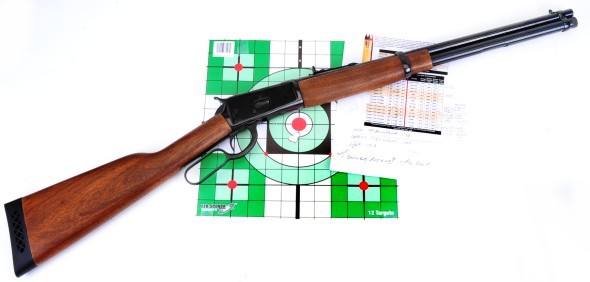 I really enjoy face to face conversation about firearms. It helps me to understand the source of communication, in context with experience and perhaps the setting. It’s amazing how much firearm knowledge seems to evaporate when a person can’t search Google or pull information from a message board thread. To recall some of the things I’ve read on the Internet about the Rossi 454 Casull, as currently manufactured by Taurus, and then compare it to the rifle that is parked next to my desk… I’d guess it was not the same firearm.
I really enjoy face to face conversation about firearms. It helps me to understand the source of communication, in context with experience and perhaps the setting. It’s amazing how much firearm knowledge seems to evaporate when a person can’t search Google or pull information from a message board thread. To recall some of the things I’ve read on the Internet about the Rossi 454 Casull, as currently manufactured by Taurus, and then compare it to the rifle that is parked next to my desk… I’d guess it was not the same firearm.
The Model R92’s ability to handle the 454 Casull’s 65,000 PSI is widely debated, although I am not sure why. The beefiest revolvers chambered for the 454 Casull have a measured maximum cylinder wall thickness of 0.108″. The Rossi’s barrel shank chamber wall thickness is 0.160″ and it is held in the rifle’s receiver which adds another 0.160″ in wall thickness for a total of 0.320″ of heat treated steel around the 454 Casull cartridge. So much for hoop stress.
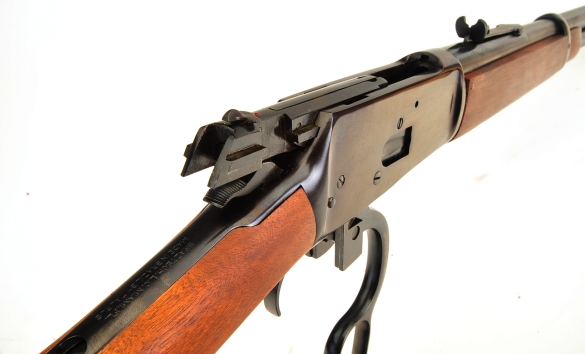
In regard to bolt thrust, the Model R92’s square bolt side rails are held captive in slots cut into the gun’s 0.250″ thick steel receiver walls. As a result, the bolt and its breech face are located and supported longitudinally and vertically; always in alignment with the gun’s bore centerline and always supported solidly when the breech is closed. The gun’s lever toggles left and right steel locking bolts that key the rifle’s bolt to its receiver when the breech is closed. Each bolt measures 2.180″ high, 0.600″ deep and 0.220″ wide. That’s about 0.959 square inches of front locking bolt contact surface, nearly four times that of a typical two lug bolt action rifle.
The point is that the Winchester 1892, which Rossi/Taurus has cloned, was Browning’s version of the WSM rifle, as opposed to the Model 1886, which was Browning’s rendition of the Ultra Mag rifle. So the design is clearly up to the task, which leaves the second half of the strength equation, materials selected and manufacturing process control. Rossi rifles are manufactured for Rossi in the Forjas Taurus S.A. ISO 9001 facility in São Leopoldo, Brazil, a company with 4,700 employees, net revenues of approximately $250 million and servicing 15% of what Taurus defines as a $2.6 Billion firearms market. This suggests that the company is large enough to invest in state of the art manufacturing capital equipment. A close inspection of the investment cast, MIM and machined parts of the R92 indicates the investment is being put to good use.
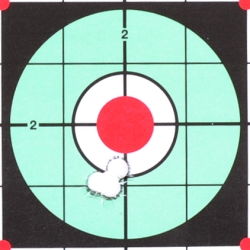 If the Rossi R92 has a sight range of adjustment issue, as I have read numerous times, it did not show with any bullet weights we shot. This 0.6″ group, left, was shot at 25 yards with a 300 grain load and without touching the Rossi’s metallic sights. The sight step was factory preset at the lowest position. Different bullet weights did move point of impact, but not by much and there was never a time when there was not enough range of adjustment to place shots to line of sight.
If the Rossi R92 has a sight range of adjustment issue, as I have read numerous times, it did not show with any bullet weights we shot. This 0.6″ group, left, was shot at 25 yards with a 300 grain load and without touching the Rossi’s metallic sights. The sight step was factory preset at the lowest position. Different bullet weights did move point of impact, but not by much and there was never a time when there was not enough range of adjustment to place shots to line of sight.
Why 25 yards? Knee high snow at the range, sub zero temps and the distance showed enough to demonstrate the rifle’s personality. After watching the mini series “Klondike” on the history channel, I realize I was being a big girl about the inclement weather and dragged the targets out to 50 yards.
On the issue of personality… recoil. A 300 grain 454 Casull round, when fired from a 20″ rifle barrel, is approximately 100 fps faster than a standard low pressure 45-70 Gov’t round with the same bullet weight, but about 300 fps less than a high performance 300 grain 45-70 high pressure load. Subsequently, while the 454 Casull may be a stout handgun round, it is moderately powerful as a rifle round. It is not a “beast”, it does not have hellacious recoil and the rifle’s 6.5 lb weight and ample recoil pad make recoil… uneventful.
454 Casull is not the same as 45 Colt… honest
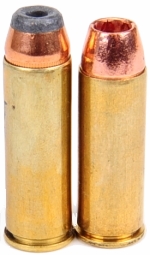 When we posted a preliminary comment about the Rossi R92 454 Casull on our Facebook page, someone asked if they could use 45 Colt ammo in the rifle. Immediately a half dozen people chimed in “Sure, I do it all the time”. Our comment, at that time was, we didn’t know. However, we did note that the rifle is not marked for this use and that nothing in the rifle’s manual or the manufacturer’s web site suggested this practice and that omission suggests something.
When we posted a preliminary comment about the Rossi R92 454 Casull on our Facebook page, someone asked if they could use 45 Colt ammo in the rifle. Immediately a half dozen people chimed in “Sure, I do it all the time”. Our comment, at that time was, we didn’t know. However, we did note that the rifle is not marked for this use and that nothing in the rifle’s manual or the manufacturer’s web site suggested this practice and that omission suggests something.
For all intent and purposes, the 45 Colt and 454 Casull share a common rim, casehead and headspace dimension. The Colt operates at an anemic 14,000 PSI maximum pressure in comparison to the Casull’s 65,000 PSI. Other than the issue of shooting a round too short for the rifle’s chamber and having it possibly experience chamber fouling, incomplete chamber sealing and inaccuracy, for the most part, the use of 45 Colt ammunition renders the Rossi unreliable. Again, Rossi never suggested their product is to be used with 45 Colt ammunition.
Below are five common 45 Colt factory loads L-R: Barnes, Hornady, Black Hills, Buffalo Bore, and Winchester. The only round that could be side receiver loaded, fed, chambered, and fired normally was the center cartridge… Black Hills Cowboy ammo.
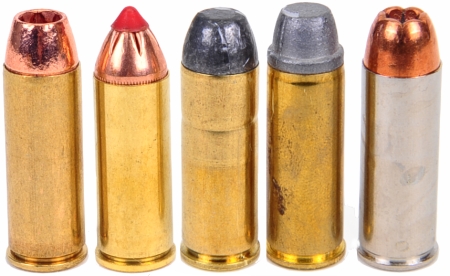
1) Didn’t side load, didn’t feed to chamber 2) Side loaded, didn’t feed to chamber 3) Side loaded and chambered 4) Side loaded and chambered 5) Side loaded, didn’t feed to chamber. If you look closely, you’d notice the cases with an exposed case mouth had the problems. In all cases, the 45 Colt round was released from the guide rails prematurely, which caused the case rim to drop low on the bolt face, while putting the cartridge at a steep angle, which caused the case mouth to hang on the top radius of the rifle’s chamber. The Barnes fed one round through the rifle’s loading gate, but the wide hollow point hung on the entrance to the magazine, preventing any additional rounds to be loaded. Rounds that would not feed were single loaded by hand and all fired normally.
Handload considerations…
The 454 Casull can be loaded down for recreational target practice and up for big game hunting, however, bullets section tends not to be interchangeable. Lighter weight bullets, and bullets intended for the 45 Colt, tend to have relatively thin jackets and soft lead cores to assure proper expansion and weight retention at relatively low velocity. Bullets intended for the 454 Casull and other 45 caliber magnum rounds have much thicker jacket construction to function properly at much higher velocity.Loading a bullet intended for low velocity applications into 454 Casull full up loads can be inaccurate as a minimum and pressure spike inducing as a possibility. Under normal circumstance, start pressure on the heel of a bullet will do little to change its form. As a bullet progresses through the barrel throat and contacts the rifling, pressure rises and expands the bullet to groove diameter and seals the bore… bullet obturation. Pressure required to even begin this forming process is approximately 12,000 PSI, but varies with bullet hardness and construction.
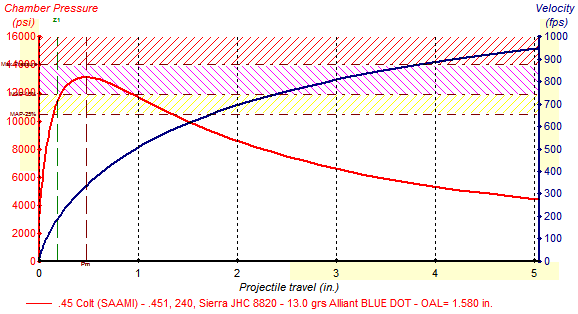
Graphed above, a standard pressure 45 Colt 240 grain bullet travels approximately 0.250″ before pressure exerts an influence on bullet dimensions and it never rises to a level that will do more than seal the gun’s bore. Bullets designed for this type of 45 Colt application will form properly under these circumstances.
Take that same 240 grain, lightly jacketed bullet and load it to 454 Casull pressure specs and the curve looks as graphed below. The bullet is exposed to 50,000+ PSI and rapidly expands before it ever gets near the firearm’s rifling, This means areas of the firearm are exposed to unanticipated high levels of pressure, which causes erosion, and pressure spikes when the oversized bullet contacts the firearm’s rifling.
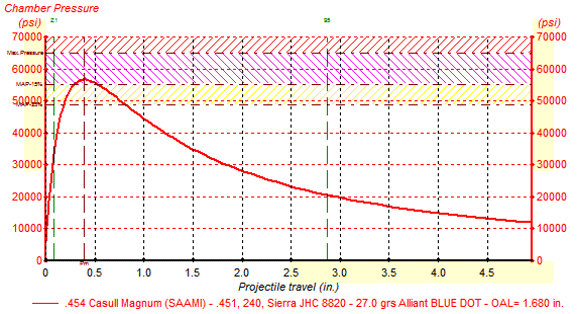
The solution, when handloading the 454 Casull, is to light load bullets made for 45 Colt applications for recreational target shooting and practice and select bullets of heavy construction for Casull level loads for hunting and protection applications. Great, Joe, how did you get so smart? Never did. I just read the forward for each cartridge as presented in any and every mainstream bullet manufacturer’s reloading manuals… which is why light bullet 454 Casull data often is posted with lower velocity than the heavy weight bullets. Yes, I could have just Googled and found solace in anonymous consensus, or asked JJDipple48 on a message board, but I am very old and place a lot of value on the dozen or so decades I have left.
The 454 Casull is not a cartridge that offers a lot of charge latitude. Pressure rise comes in a sharply escalating curve as powder charges increase to maximum. The cartridge produces more than adequate performance when operating within spec pressure and recommended loads.
Joe, did you ever stop talking and put any handloads together?
Glad you asked, because I certainly did. Only one of bullets below would feed correctly. The 360 grain True Shot cast bullet, below, far right, was just too long and its 0.355″ meplat was too large. As pictured below, the feed rails are still hanging tight while the bullet’s nose is wedged tight at the entrance to the rifle’s chamber. The COL functional limit actually comes in slightly less than the Casull’s 1.765″ spec at 1.760″

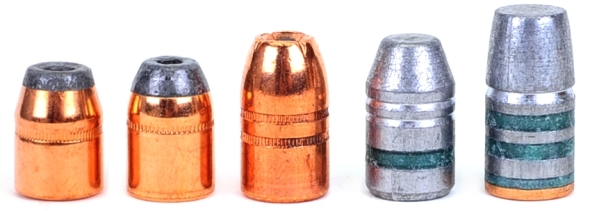
The 360 grain was not omitted from the load data as it is a terrific bullet, very accurate and hard hitting, even if loaded single shot. I may rework the guide rail timing to accommodate this and similar bullets. The bullets appear on the table, top to bottom, in the order they appear above, left to right. The first two are light construction and suitable for moderate pressure, moderate loads for recreational target practice and for use on small to medium size game. The middle bullet is a tough jacketed bullet, made for this type of cartridge and can be loaded to the Casull’s potential. The two cast bullets can be loaded heavy and are suitable for big game, however, the Rossi would need to be modified to feed the latter reliably.
 |
Warning: Bullet selections are specific, and loads are not valid with substitutions of different bullets of the same weight. Variations in bullet material and length will alter net case capacity, pressure and velocity results. Primer selection is specific and primer types are not interchangeable. These data represents maximum loads in our firearms and test equipment and may easily be excessive in other applications. All loads should be reduced by 3%, and developed following safe handloading practices as represented in established reloading manuals produced by component manufacturers. Presentation of these loads does not constitute a solicitation for their use, nor a recommendation.
|
||||||||||||||||||||||||||||||||||||||||||||||||||||||||||||||||||||||||||||||||||||||||||||||||||||||||||||||||||||||||||||||||||||||||||||||||||||||||||||||||||||||||||||||||||||
|
|
|||||||||||||||||||||||||||||||||||||||||||||||||||||||||||||||||||||||||||||||||||||||||||||||||||||||||||||||||||||||||||||||||||||||||||||||||||||||||||||||||||||||||||||||||||||
So what’s up with the Rossi?
The Rossi is a much better rifle than I anticipated; very sound and accurate. Aesthetically it could be a terrific rifle if Taurus put a little more into minimize the effects of handling during assembly. The basic rifle is very good and, even in current state, I would not be embarrassed by its appearance. I wish Taurus would put a little finesse into the feed system to better time it for maximum spec length and with blunt tipped heavy cast bullets. I REALLY wish Taurus would drill and tap the receiver for scope and/or peep sight mounting for us mature guys who like these lever gun more than anyone else.
Braztech customer service for this Rossi needs to be fixed. It is unconscionable that a customer and owner of one of the company’s rifles would not have phone access to ask tech questions or arrange for repair of a firearm. I know it is very fashionable for companies with an Internet presence to seal themselves off from customers with a non-responsive web form. A Braztech stated one hour phone wait for a customer service agent is just an attempt to herd customers to a web page in hopes they will take their problems and go away.
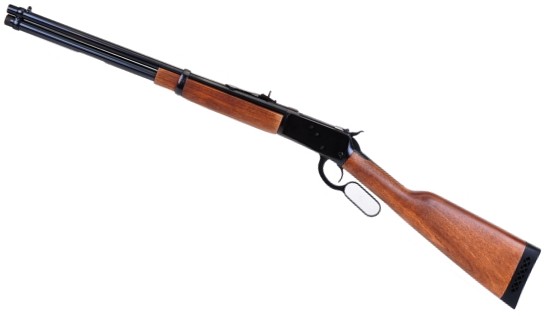
Where would I use this combination? Ballistic charts suggest the 454 Casull, with a 300 grain bullet, makes for a solid 150 yard rifle… certainly 100 yard rifles, that would be terrific for deer and black bear and probably elk and moose if a hunter could get that close. In New England woods, it is an ideal deer rifle; light to carry, fast pointing and with plenty of power.

Email Notification